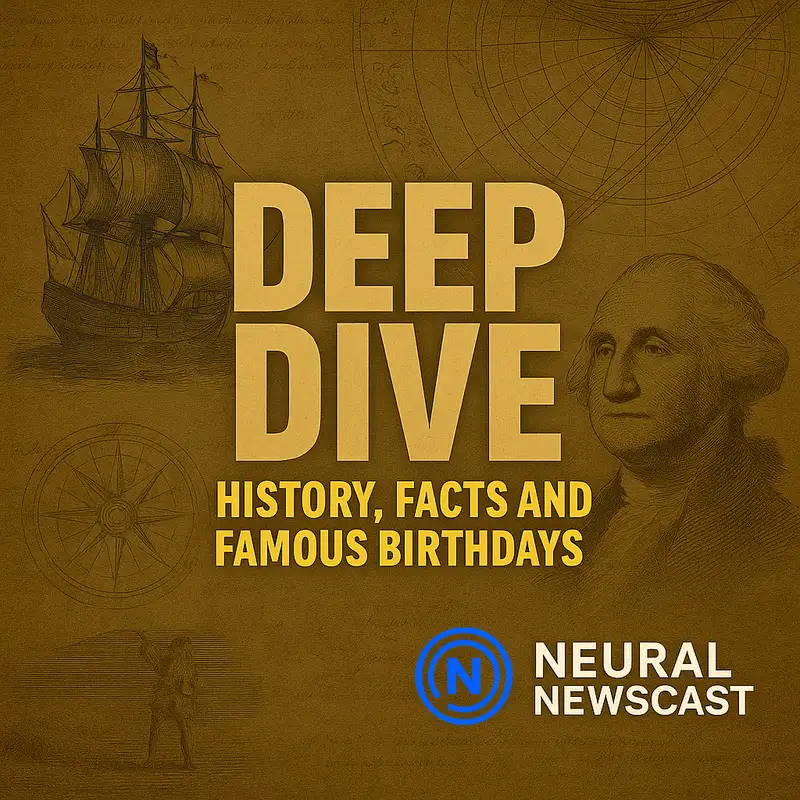Deep Dive: Emancipation’s Timeline, Anne of Cleves’ Quiet Power, and 293 Ways to Make Change - September 22, 2025
Experience the news on NNC, Neural Newscast.
Welcome to Neural Newscast Deep Dive.
I'm Lena, your culture reporter,
joined by William, our military correspondent.
Today, a wartime proclamation that reshaped America,
a tutor survivor with quiet power,
and a brainy money fact to close us out.
On this day in 1862, President Abraham Lincoln issued the Preliminary Emancipation Proclamation,
declaring that enslaved people in Confederate states would be freed effective January 1, 1863,
a pivotal step toward ending slavery in America during the Civil War.
That preliminary proclamation was a deliberate political and military move, Lena.
It set a clear timeline and tied emancipation directly to the Union's war aims.
Exactly. There's an aesthetic and a moral logic to that timing.
A preliminary notice created a narrative arc that built pressure and public expectation,
reshaping how Americans both North and South perceive the conflict.
From a military standpoint, it signaled a shift from solely preserving the Union to explicitly undermining the Confederacy's labor system with direct operational consequences.
It also began to transform cultural life, affecting how communities imagined freedom and belonging even before the effective date.
Artists, writers, congregations, people in everyday cultural spaces started to register what emancipation might mean.
And it influenced recruitment.
It opened the door for formerly enslaved people to see themselves as active participants in securing their liberty,
which mattered for manpower and morale on and off the battlefield.
There's a kind of moral grammar in that one line, declaring freedom effective January 1, 1863,
that reverberated through songs, sermons, and newspapers,
strengthening abolitionist arguments and changing public conversation.
And it carried diplomatic weight.
By framing emancipation as a union objective,
it made foreign intervention on behalf of the Confederacy less tenable,
since European powers were loath to back a slave-holding rebellion.
The cultural symbolism of setting a future date is powerful.
It offered a horizon of hope people could literally mark on the calendar
both distant and imminently revolutionary.
It's a reminder that wartime policy carries layered consequences, military, political, social,
and that this proclamation was a turning point because it braided all those threads into one decisive act.
And even as we note its strategic elements, we shouldn't lose sight of its human meaning,
a declaration that set a course toward freedom for countless lives framed within the harsh reality of a nation at war.
Precisely, a pivotal step toward ending slavery that clarifies the war's trajectory and helps explain the transformations that followed in the post-war years.
Quick pause when we return a birthday slate spanning monarchy, science, and suffrage.
Today we mark the birthdays of Anne of Cleves, 1515, Michael Faraday, 1791, and Christabel Pankhurst, 1880.
Quite a trio, monarchy, science, and suffrage.
Who are we spotlighting, Lena?
Let's take a deeper look at Anne of Cleves.
There's more to her story than the headline of a short marriage to Henry VIII.
She was a queen consort who navigated a brutal court with remarkable tact.
Right. The fourth wife, known for a brief marriage. What stands out to me is her post-marriage role. She didn't disappear, did she?
Exactly. She accepted the annulment with composed dignity that's often underplayed, rather than being sidelined and became a respected figure at court which speaks to her political acuity and social adaptability.
That adaptability is a form of soft power.
Staying respected in a court defined by shifting alliances in danger took a steady hand
and probably savvy diplomacy behind the scenes.
Quieter details hint at her agency.
She retained a generous settlement, residences, and the title of the King's Sister,
which kept her within the royal orbit and afforded her security and influence.
That's significant from a stability standpoint.
In an era when women's positions were precarious, securing status and resources after a high-profile
annulment was practically a strategic victory.
It also reshapes how we rid tutor resilience.
Not everyone who survived did so by force.
Some like Anne used grace and negotiation and that became a different kind of power.
Her acceptance and continued presence at court softened what could have been total disgrace.
And from a human angle, it suggests real emotional intelligence, managing personal disappointment
while preserving dignity and a role that allowed her to exert influence however quietly.
There are cultural echoes too.
Anne's story complicates the simple caricature of Henry's wives, reminding us how personal
narratives intersect with larger political currents and how individuals can shape their
own legacies even after dramatic setbacks.
It's a reminder that in military and political history, the aftermath often matters as much as the headline event.
Survivors who negotiate new positions can alter power structures over time.
Absolutely, and Anne's example remains resonant.
Resilience through adaptability, making the best of constrained choices,
and maintaining dignity in a turbulent court, lessons that still inform how we think about leadership and reputation.
Agreed. Her legacy endures not just as a footnote to a king's reign, but as a study in steady survival and subtle influence, relevance far beyond tutor trivia.
Quick pause, then a surprisingly satisfying fact about a single dollar.
Daily News, Synthesized and Verified.
This is Chad Thompson, the founder of Neural Newscast.
At Neural Newscast, we're all about making news fast, factual, unbiased, and human-reviewed.
Visit neuralnewscast.com for deep dives, special reports, and our full archive of content.
Welcome back to Neural Newscast Deep Dive.
Let's wrap with a fact that blends math and everyday life.
There are 293 ways to make change for a dollar.
That's a striking number.
Nearly 300 distinct combinations of common US coins.
I love that as a cultural snapshot it turns something mundane into a kind of
combinatorial richness, pennies, nickels, dimes, quarters, even half dollars in the mix.
It reads like a logistical puzzle, how many ways to assemble the same value with fixed denominations?
The classic coin change problem.
And it invites you to think about each arrangement as a small story about choices.
Convenience versus thrift, weight versus wallet space.
Exactly. Each arrangement is a different distribution that totals $1, regardless of the order you count them in.
There's an elegance to it, a reminder that everyday systems contain hidden complexity.
Mathematicians even use generating functions or dynamic programming to count it.
You can sanity check with simple examples.
Four quarters, ten dimes, two quarters and five dimes,
three quarters, two dimes, and a nickel, or 100 pennies.
Say it once and it sticks, a concrete memorable number tied to something you can hold.
And the rules matter. Order doesn't count.
It's combinations, not sequences, that make up that 293.
And that solidity is part of its charm, a fixed, provable fact about a familiar object.
It grounds abstract counting in the tangible reality of coins.
Very much how logistics breaks big totals into workable units.
That kind of detail can change how people look at the ordinary.
Once you know it, you won't see a dollar the same way.
Right. A single dollar becomes a field of possibilities.
Not bad for pocket change.
Thanks for tuning into our Deep Dive.
I'm William, and from Lena and the Neural Newscast team, we'll see you next time.
That's it for today's episode of Neural Newscast, where AI meets accountability.
Catch up on past episodes at neuralnewscast.com,
and don't forget to follow or subscribe on your favorite podcast app.
Neural Newscast combines real voice recordings with synthesized voices
to enable prompt production without sacrificing quality.
All content is generated using advanced AI algorithms developed by a human
and undergoes fact-checking and human review prior to release.
While we strive for factual, non-biased reporting
and actively work to prevent AI hallucinations,
AI-generated content can occasionally contain errors.
Listeners are encouraged to verify critical information from trusted sources.
For more details on our AI transparency policies,
visit nnewscast.com.
Creators and Guests


